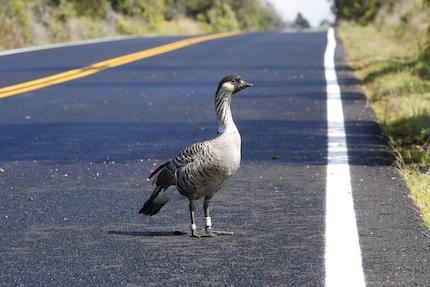A female nēnē, thought to be getting ready to nest, was killed when run over on Highway 11 by a motorist at Hawai‘i Volcanoes National Park.
The endangered goose was killed early Friday morning along Chain of Craters Road, and her mate remains near the site. The young pair was preparing to nest, according to park officials.
As nesting season begins, nēnē, particularly females, are focused on eating. They must build up enough body fat to produce eggs and sustain them through the 30-day incubation period. As a result, females and their watchful mates are out not only during the day, but are also foraging at dusk and dawn and even throughout the night when the moon is bright.
Due to recent drought conditions in the park, the vegetation is particularly dry at many of the favored breeding sites, pushing nēnē to move further afield in search of adequate food. Unfortunately, rain runoff from the pavement, combined with ground disturbance along road edges, often makes for lush grassy strips along roads, enticing birds to feed in dangerous spots. Furthermore, nēnē may be difficult to see along roadsides because their coloring often blends in with the surrounding area.
The park has placed nēnē crossing signs on roads where birds are known to congregate or cross, and where vehicle kills occur most frequently. Motorists are urged to pay attention to the signs and proceed cautiously.
“It’s imperative that drivers use caution throughout all nēnē crossing zones. It is understandable that people get complacent when they do not see nēnē in these areas for a long time; however, the park strongly urges motorists to pay attention to the signs and slow down,” said park wildlife biologist Kathleen Misajon.
Incidents of people feeding nēnē also have contributed to recent vehicle kills, Ms. Misajon said. On Oct. 1, a 16-year-old male – a father of three fledglings last season – was killed by a vehicle along Highway 11, one mile outside of the park’s Ka‘ū boundary. He was likely drawn to this location by feeding, which continues to be a problem at this site, attracting more nēnē to the roadside and increasing their odds of becoming the next road kill.
“Nēnē have significant threats to contend with, from predation by cats, mongooses and other introduced predators, to loss of habitat made worse by drought conditions. This species is really fighting an uphill battle. We ask the public to help us rebuild nēnē populations by minimizing vehicle-related nēnē deaths,” Ms. Misajon said.




Add comment